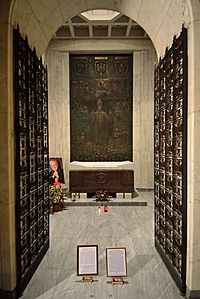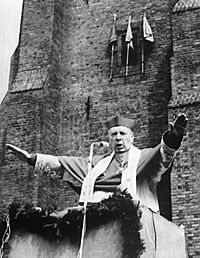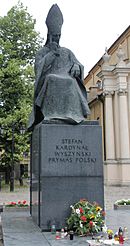Stefan Wyszyński facts for kids
Quick facts for kids Blessed Stefan Wyszyński |
|
|---|---|
| Cardinal Archbishop of Gniezno Archbishop of Warsaw Primate of Poland |
|
 |
|
| Church | Catholic Church |
| Appointed | 12 November 1948 |
| Enthroned | 2 February 1949 (Gniezno) 6 February 1949 (Warsaw) |
| Reign ended | 28 May 1981 |
| Predecessor | August Hlond |
| Successor | Józef Glemp |
| Other posts | Apostolic Administrator of Lviv of the Armenians (1954-81) President of the Polish Episcopal Conference (1956-81) Cardinal-Priest of Santa Maria in Trastevere (1957–81) |
| Orders | |
| Ordination | 3 August 1924 |
| Consecration | 12 May 1946 by August Hlond |
| Created Cardinal | 12 January 1953 |
| Rank | Cardinal-Priest |
| Personal details | |
| Birth name | Stefan Wyszyński |
| Born | 3 August 1901 Zuzela, Congress Poland, Russian Empire |
| Died | 28 May 1981 (aged 79) Warsaw, Poland |
| Previous post | Bishop of Lublin (1946–48) President of the Polish Episcopal Conference (1948-53) |
| Motto | Soli Deo ("To God alone") |
| Signature | |
| Coat of arms |  |
| Sainthood | |
| Feast day | 28 May |
| Venerated in | Catholic Church |
| Beatified | 12 September 2021 Temple of Divine Providence, Wilanów, Warsaw, Poland by Cardinal Marcello Semeraro on behalf of Pope Francis |
| Attributes | Cardinal's attire |
| Patronage |
|
| Styles of Stefan Wyszyński |
|
|---|---|
 |
|
| Reference style | His Eminence |
| Spoken style | Your Eminence |
| Informal style | Cardinal |
| See | Warsaw |
Stefan Wyszyński (born August 3, 1901, died May 28, 1981) was an important leader in the Catholic Church in Poland. He served as a bishop in Lublin from 1946 to 1948. Later, he became the Archbishop of Warsaw and Archbishop of Gniezno from 1948 to 1981. He was made a cardinal by Pope Pius XII in 1953. He was also known as the Primate of Poland, a very important religious title.
Many people saw him as the spiritual leader of the Polish nation. He stood strong against the Communist government that ruled Poland from 1945 to 1989. He is remembered for helping Polish Christianity survive during this time. He was even put in prison for three years because of his beliefs. Many consider him a national hero in Poland.
His journey to becoming a saint began in 1989. He was given the title of Venerable by Pope Francis in 2017. He was officially beatified (a step before sainthood) on September 12, 2021.
Contents
Early Life and Becoming a Priest
Stefan Wyszyński was born in a small village called Zuzela in eastern Mazovia, Poland. At the time, this area was part of the Russian Empire. His family was part of the Polish nobility, but they were not rich.
Stefan's mother passed away when he was only nine years old. In 1912, his father sent him to Warsaw for school. He later went to a seminary in Włocławek to study for the priesthood. On his 23rd birthday, August 3, 1924, he became a priest.
Studies and Teaching
After becoming a priest, Wyszyński celebrated his first special Mass at Jasna Góra Monastery in Częstochowa. This place is very important to Polish Catholics. It holds the famous painting of the Black Madonna of Częstochowa, who is seen as Poland's protector.
Wyszyński then spent four years in Lublin. In 1929, he earned a special degree in Canon Law (church law) and Social Sciences from the Catholic University of Lublin. His studies focused on the rights of families, the Church, and the state regarding schools. After graduating, he traveled around Europe to continue his education.
When he returned to Poland, Wyszyński started teaching at the seminary in Włocławek.
During World War II
When World War II began in 1939 with the German invasion, Wyszyński had to leave Włocławek. The Gestapo (Nazi secret police) wanted to arrest him because he had written articles criticizing the Nazis.
During the Warsaw Uprising in 1944, he became a chaplain (a priest serving in the military or a hospital). He helped at a hospital for injured fighters in Laski and with the Polish underground resistance group called the Armia Krajowa.
Wyszyński also helped Jewish people during the Nazi occupation. He helped hide a Jewish father and his two children. He also encouraged others to help Jews who were "running from the fire of war."
After the war ended in his area in 1945, Wyszyński went back to Włocławek. He worked to rebuild the damaged seminary and became its leader. He also edited a Catholic newspaper.
Becoming a Bishop and Resisting Communism
Just one year later, in 1946, Pope Pius XII made him the Bishop of Lublin. In 1948, after the death of Cardinal August Hlond, Wyszyński was named Archbishop of Gniezno and Archbishop of Warsaw. This made him the Primate of Poland.
Standing Up to Communism
After World War II, a Communist government took control of Poland. Many Poles and the Catholic Church did not agree with this new government. The government began taking away church property.
In 1950, Wyszyński tried to make an agreement with the Communist leaders. This agreement allowed the Church to keep some property and tried to separate the Church from politics.
However, in 1953, the government started to persecute the Church again. When bishops continued to support those who resisted communism, the government began arresting priests. Cardinal Wyszyński was arrested on September 25, 1953. He was imprisoned in different places and later placed under house arrest. During his imprisonment, he saw how harshly people were treated. He was finally released on October 26, 1956.
Cardinal and Primate of Poland

On January 12, 1953, Pope Pius XII made Wyszyński a cardinal. However, he was not officially given his cardinal title until 1957.
He continued his important religious and social work. A major event was the celebration of Poland's Millennium of Christianity in 1966. This marked 1,000 years since Poland's first ruler, Mieszko I, was baptized. During this celebration, the Communist government would not let Pope Paul VI visit Poland. They also stopped Cardinal Wyszyński from attending events outside Poland.
Wyszyński saw a great triumph in 1978 when Karol Wojtyła from Kraków was elected Pope John Paul II. This was followed by a huge and exciting visit by the Pope to Poland in 1979. Wyszyński also spoke out during the civil unrest in 1980. When the Solidarity trade union was formed, he asked both the government and the striking workers to act responsibly.
Cardinal Wyszyński, often called the Primate of the Millennium, died on May 28, 1981. He was 79 years old and had abdominal cancer. He is buried in St. John's Archcathedral in Warsaw. The cardinal had heard about the attempt to assassinate the pope and offered his own life for the Pope's safety.
In 2001, the Polish Parliament (the Sejm) declared it the "Year of Cardinal Stefan Wyszyński" to remember him. They honored him as a "great Pole, chaplain, and statesman."
Legacy and Recognition
Many things have been done to remember Cardinal Wyszyński. In 1981, a composer named Krzysztof Penderecki wrote a piece of music in his memory. In 2000, a movie called The Primate – Three Years Out of a Thousand was made about his life and time in prison. Another movie about his life, Prophet, was made in 2022.
In a TV show about Pope John Paul II, Cardinal Wyszyński was played by the actor Christopher Lee.
The Cardinal Stefan Wyszyński University in Warsaw is named after him. A museum dedicated to both Pope John Paul II and Primate Wyszyński is being built in Warsaw.
Beatification Process
| Blessed Stefan Wyszyński Archbishop of Warsaw, Primate of Poland |
|
|---|---|
 |
|
| Cardinal and Confessor | |
| Born | 3 August 1901 |
| Died | 28 May 1981 (aged 79) |
| Venerated in | Catholic Church |
| Beatified | 12 September 2021, Warsaw, Poland by Cardinal Marcello Semeraro on behalf of Pope Francis |
| Feast | 28 May |
| Attributes | Cardinal's attire |
| Patronage | Persecuted Christians, Civitas Christiana |
The process to make Cardinal Wyszyński a saint began in 1989. This first step gave him the title of Servant of God. The official investigation into his life started in 1989 and finished in 2001.
In 2017, Pope Francis confirmed that Wyszyński lived a life of great virtue. This gave him the title of Venerable.
A special investigation also looked into a possible miracle linked to him. This investigation started in 2012 and finished in 2013. The details were sent to Rome for review. In 2018, medical experts in Rome approved the miracle. Church leaders also confirmed it in 2019.
On October 3, 2019, the Church officially approved the miracle. This was the final step before his beatification. His beatification was planned for June 7, 2020, but it was delayed because of the COVID-19 pandemic. It was rescheduled and celebrated on September 12, 2021. Cardinal Marcello Semeraro led the ceremony on behalf of Pope Francis.
See also
 In Spanish: Stefan Wyszyński para niños
In Spanish: Stefan Wyszyński para niños
- Letter of Reconciliation of the Polish Bishops to the German Bishops
Books
- Love and Social Justice: Reflections on Society, Arouca Press, 2021 ISBN: 978-1989905913




